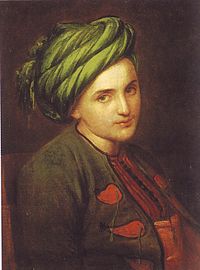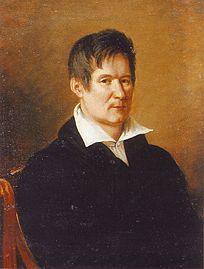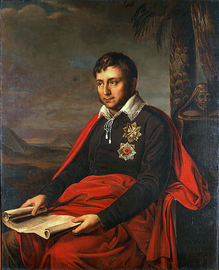Alexander Varnek
 From Wikipedia the free encyclopedia
From Wikipedia the free encyclopedia
Alexander Varnek | |
|---|---|
| Александр Варнек | |
 Varnek, Self-Portrait (1804) | |
| Born | 15 February 1782 |
| Died | 19 March 1843 (aged 61) Saint Petersburg, Russian Empire |
| Education | Member Academy of Arts (1810) |
| Alma mater | Imperial Academy of Arts (1803) |
| Known for | Painting |
| Movement | Orientalist |
| Awards | |
Alexander Grigoryevich Varnek (Russian: Александр Григорьевич Варнек; February 15, 1782 – March 19, 1843) was a Russian painter. He was known for his portraits of figures in Russian society.
Biography[edit]
He was a pupil of Dmitry Levitzky and Stepan Shchukin at the Imperial Academy of Arts.[1] He went abroad (1801–1809) as a representative of the Academy and later returned as professor and advisor.[2]
Along with other artists of the period, Varnek was somewhat restricted in his choice of subject matter due to the political climate and censorship that operated, especially during the reign of Nicholas I. Under censorship, artists were expected to be complacent about the conditions of Russian life. Patrons who commissioned work rarely strayed from acceptable religious and historical themes while artists who chose their own subjects tended to confine themselves to "safe themes."[3] Thus, Varnek's specialty became portraiture.
In his own lifetime, he was regarded as a "celebrity artist."[4]
Work[edit]
He was particularly noted for his masterful drawing, his harmonious, if not particularly vivid coloring, the ability to capture a close resemblance, appropriate lighting, and in general for his conscientious execution without embellishment. Contemporaries highly rated his portraits, consequently he created many works of this sort. Particularly striking are his many portraits; a portrait of Madame Khatova (the wife of General Alexander Ilich Khatov), a life-size portrait of Count Alexander Stroganov, a portrait of the former president of the Academy, Alexey Olenin, and the paintings "Head of a Young Turk", "Boy with Dog", and "Fiddler". In addition, Varnek painted icons representing the Annunciation and the Four Evangelists. These latter are in the chapel of the Academy of Arts.
Selected portraits[edit]
- Captive Turk
in Green Turban - Vasily Stasov (c.1820)
- Alexey Olenin (1824)
- Jan Potocki (c.1810)
- Anna Bunina (c.1812)
References[edit]
- ^ Gosudarstvennyĭ russkiĭ muzeĭ, The Russian Museum: A Short Guide: Ancient Russian Art, 18th Century Art, Art in the First Half of the 19th Century, Saint Petersburg, (Russia), Foreign Languages Publishing House, 1955, p. 106; Hunter-Stiebel, P., Stroganoff: the palace and collections of a Russian noble family, Portland Art Museum in collaboration with Harry N. Abrams, 2000, p. 161
- ^ Neverov, O., Borisovich, M P., The Hermitage: Essays on the History of the Collection, Slavia Art Books, 1997, p. 71
- ^ Perkins, E.L., "Nicholas I and the Academy of Arts," Russian History, Vol. 18, No. 1, 1991, https://www.jstor.org/stable/24656544, pp 51-63
- ^ Neverov, O., Borisovich, M P., The Hermitage: Essays on the History of the Collection, Slavia Art Books, 1997, p. 14
Further reading[edit]
- СТАРАТЕЛЬ, Русская живопись: Biography (in Russian)




